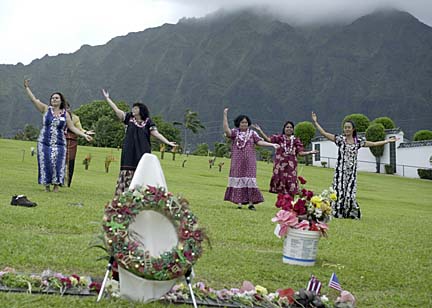
Hula Halau Ho'onani 'O Ko'olau, made up of Hawaii State Hospital staff, clients and former patients, danced at a memorial for 668 patients who died there and were forgotten for a number of years. A marker stands where the patients are buried.
State Hospital
patients honoredThe annual service remembers
668 who died in the mid-1900s
Ellen Awai doesn't need to fly to Maui to honor her grandfather at his grave site because his name is engraved on one of the two bronze plaques at Hawaiian Memorial Park in Kaneohe.
Untaro Ingata wasn't forgotten and neglected in life and death like some of the 667 other patients who died while in the care of the then-Territorial Hospital, now known as the Hawaii State Hospital, between 1930 and 1960.
Ingata was buried on Maui by family and friends. Even though her grandfather died when she was just 2, Awai stills tries to visit him in Kaneohe as often as possible.
"I just wish more of my family members could have come today," said Awai, 48, who was also a patient of the Hawaii State Hospital for two years.
Hospital patients, staff and friends gathered yesterday afternoon in the third annual service to remember the 668 patients. Most of the patients were not given a proper burial when relatives failed to retrieve their ashes, which were set aside for years in a dark, damp room of the basement.
Now their ashes are inurned at the Kaneohe cemetery, and their names are finally being remembered.
"We may not agree with the past, but we must honor it," said Paul Guggenheim, Hawaii State Hospital administrator. "We have to respect what we do and continue it in the future."
Hospital staff and patients honored the dead with a blowing of a conch shell, a moment of silence, hula dances by the hospital halau, speeches, a prayer and a speaking of the names.
"We speak their names so that they may be heard," said chaplain Dave Edwards.
People lined up to place a flower on the plaques as some of the names were read aloud by current patients.
"This should have never happened," said Charlene Ryerson, a hospital peer specialist. "We have to remind people that this still happens today. People are being forgotten and should be honored."
When the hospital opened in 1930, a territorial law prohibited using taxpayer funds to bury patients. In 1960 the hospital finally received money from the state Legislature to place all 668 remains in urns, and buried them in four concrete vaults of the cemetery.
The two bronze plaques contain 541 names; 127 patients are unknown because the containers broke or the labels with their names became illegible after mildew damage from the years they were locked away in the basement.
"For them to be 'unidentified patient No. 26' is heartbreaking," said the Rev. Phyllis Meighen, who visits the hospital monthly.
Dr. William Cody, who was the hospital medical doctor from 1959 to 1963, was at the first memorial service on July 1, 1960.
"I remember when I was the only one who would visit the grave site for years," he said. "I was surprised to see how many people showed up today."
